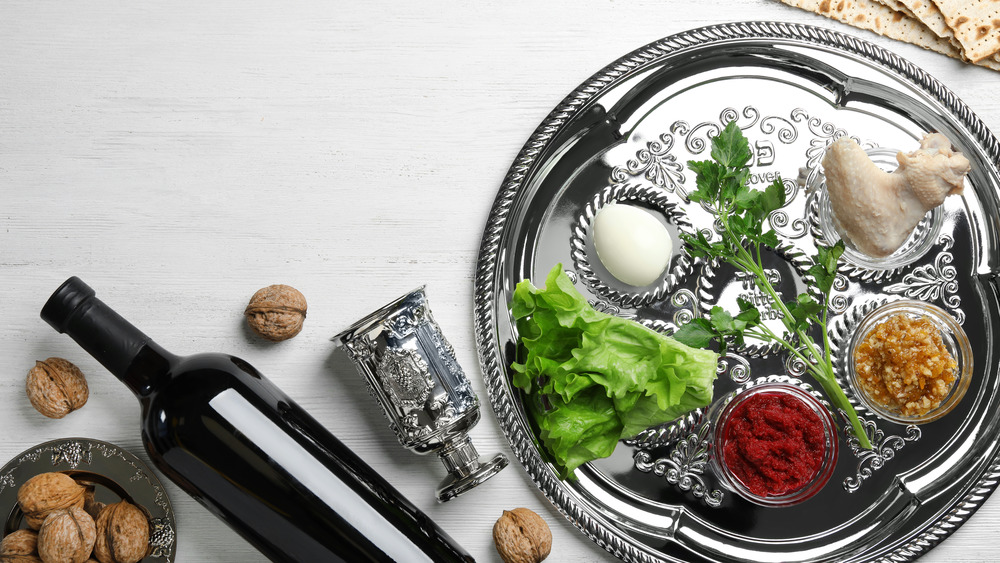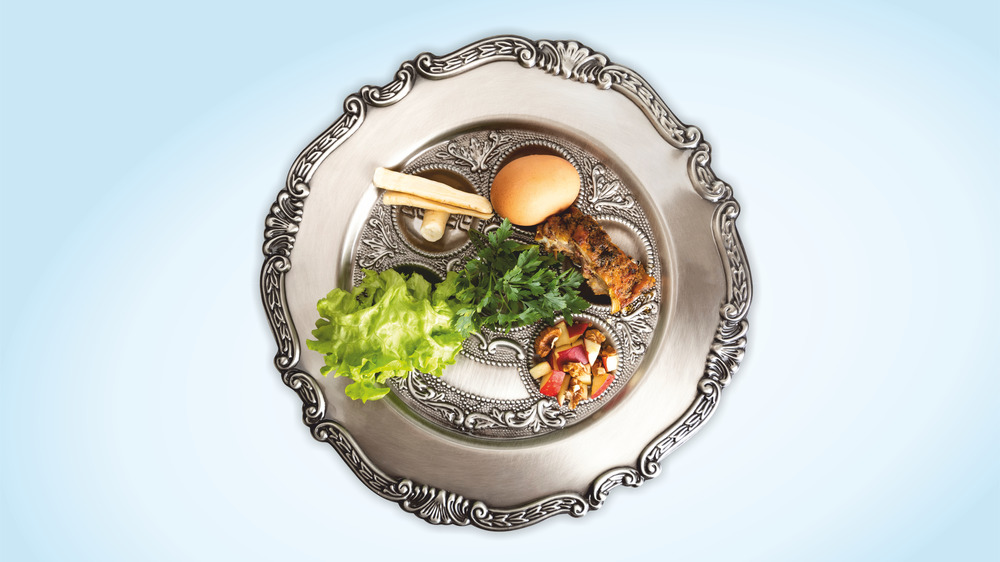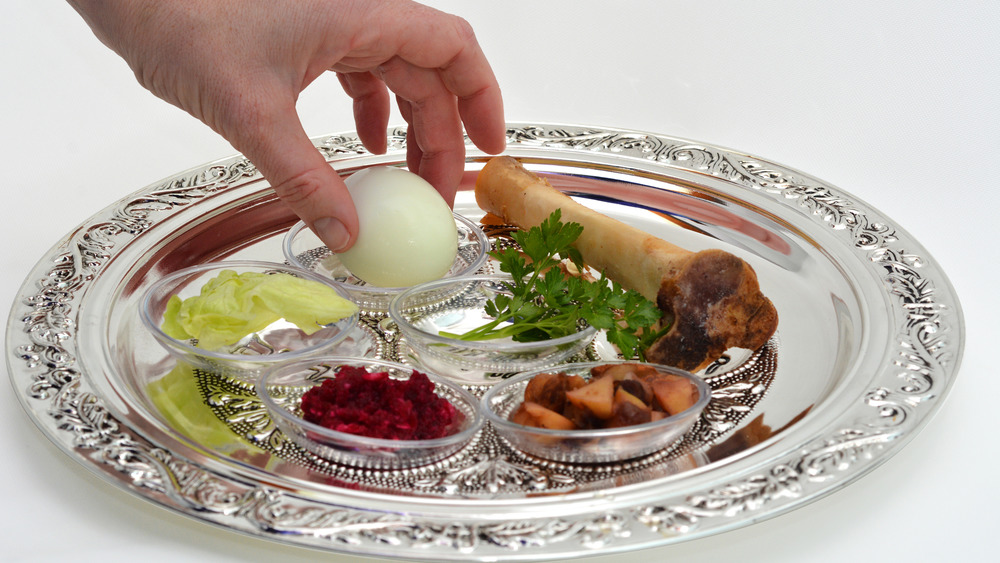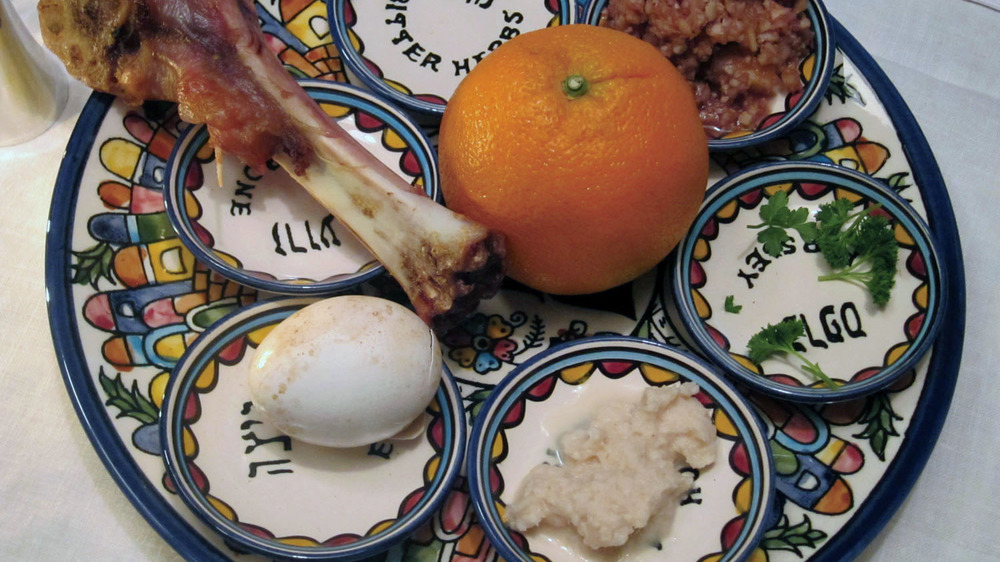Here's What A Seder Plate Really Means
If you grew up practicing Judaism, you understand Passover and know the whole drill backward and forwards — what you say, where you sit, what you do. There's actually a set of written instructions for the Passover seder called the Haggadah (via My Jewish Learning) that explains it all for you, including everything that goes on the seder plate that sits in the middle of the table.
Should you be unfamiliar with Passover traditions and celebrating with Jewish friends or family, however, you may be wondering — what's up with that plate of food in the middle of the table? Are you supposed to eat it, or just look at it, or what? Traditionally, a seder plate sits at the center of the table holding up to six symbolic items (via My Jewish Learning). While the Jewish Telegraphic Agency suggests you not eat what they jokingly describe as "a charred piece of meat, a blackened hard-boiled egg, a wilted lettuce leaf and a glob of what looks like industrial spackle," it is actually traditional to consume at least a token amount of most of the seder plate items. It might help, though, if you know what they are as well as what they are meant to stand for.
The symbolism behind the seder plate foods
The seder plate typically includes six different items: karpas, maror, hazeret, haroset, zeroa, and beitzah, along with a side of matzah. If the only name you recognize is matzah (sometimes spelled matzo), that's okay, we're going to break it all down for you. Those matzos (or matzahs) may not actually sit on the plate, but they are a necessary adjunct, nonetheless. There need to be three of these, wrapped in a napkin, and Food Network explains that they represent the hasty flight out of Egypt.
Karpas is a green vegetable, usually parsley, and while Food Network says it represents spring, My Jewish Learning says it's more complicated than that. In addition to representing the green of new spring growth, the karpas stands for the initial flourishing of the Jews in Egypt, but it is dipped in salt water (Ashkenazi) or vinegar (Sephardic) before being eaten to represent the tears of enslaved Israelites.
Maror and hazeret are the "bitter herbs." Grated horseradish root is often used for maror, and you're supposed to eat it in order to symbolically taste how bitter slavery was for the Israelites. Hazeret, the second bitter herb, may be romaine or another type of bitter-tasting lettuce. Romaine can be bitter as it ages. Hazeret, however, doesn't appear on every seder plate, since some prefer to use maror alone.
Other items on the seder plate
The next item on the seder plate is haroset. Haaretz notes that haroset is a sweet paste, usually red or brown in color, and it is meant as a reminder of the clay used by the Israelite slaves to make bricks for their Egyptian owners. There are numerous recipes for this traditional dish, but haroset from the Ashkenazi tradition usually includes apples, walnuts, and red wine while Sephardic haroset is more likely to contain dates and/or other types of dried fruits.
Zeroa is a roasted bone (traditionally a lamb shank, but even a chicken bone will do) containing a little meat, and it stands for the Paschal lamb that was sacrificed in the Temple in Jerusalem during ancient times, according to Hareetz. The zeroa, unlike the other seder plate items, is not eaten, although sometimes vegetarians who do not want to cook meat will use a roasted beet in place of the bone. This is permissible since the Talmud does mention beets as a seder vegetable. The beitzah is a roasted or boiled egg, which represents a Temple sacrifice called the hagigah, but it also stands for the cycle of life.
Seder plates can contain additional symbolic items
While My Jewish Learning tells us that the seder plate is typically arranged in a certain way — usually maror in the middle, hazeret at six o'clock, karpas at seven o'clock, beitzah at eleven o'clock, zeroa at one o'clock, and haroset at five o'clock — Haaretz notes that most Seder plates label where each item goes so no memorization is required. Despite these rules, it's permissible to add additional items to the Seder plates as long as they have a symbolic value that fits the celebration.
As Passover commemorates the liberation of the Israelites from bondage, today's celebrations sometimes speak to contemporary struggles for freedom. An orange may stand for the fruitful contributions women and the LGBTQ+ community can make to Judaism, while an olive may stand for the hope of a reconciliation between modern-day Israelis and Palestinians (via Jewish Telegraphic Agency).
At Harvard University, an annual Freedom Seder (via The Atlantic) sponsored by both the Black and Jewish law students associations has featured such contributions as a bunch of grapes symbolizing the exploitation of Hispanic migrant workers. According to NPR, an African-American Seder might make certain substitutions to reflect a more recent period of enslavement than that of the Israelites: collard greens as maror or hazeret, hoecakes as matzoh, and a sweet potato as karpas. Struggling to overcome oppression, after all, is something more than one group of people has in common, and food is a symbol that likewise transcends cultures.



